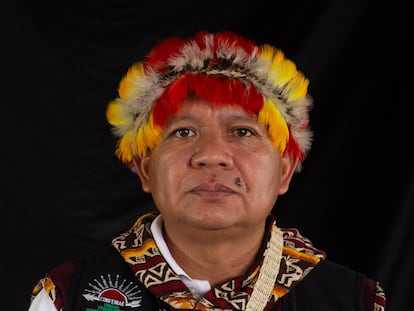Portrait of a sad tree (with exotic animals)
To depict the planet’s shrinking biodiversity, Mexican biologist and illustrator Marco Antonio Pineda drew a tree with eight extinct animals and eight others under threat
The Tree of Life – I’m not referring to the fallen ahuehuete [Montezuma cypress] sacred tree that conquistador Hernán Cortés supposedly cried over when the Mexica people defeated him in 1520. Nor am I talking about the most famous sycamore in Britain that stood for centuries over Hadrian’s Wall until some fool chopped it down. I’m talking about a scientific illustration by Marco Antonio Pineda, a Mexican biologist and nature artist, that accompanied Mutilation of the tree of life via mass extinction of animal genera, an article by Gerardo Ceballos published in the Proceedings of the National Academy of Sciences (PNAS) journal. Ceballos is a renowned ecologist who wants to alert the world to the mass extinction of living beings on Earth. His co-author, Paul R. Ehrlich, is a nonagenarian entomologist who wrote the controversial The Population Bomb (1968) with his colleague and wife, Anne H. Ehrlich.
For over 20 years, Ceballos and Ehrlich have aimed to raise awareness among their peers and the public regarding the biodiversity crisis. Initially, they highlighted the loss of populations as a precursor to species extinction. Now, they urge research and conservation efforts to focus on the loss of broader taxonomic groups.
Pineda used the concept in the article by Ceballos and Ehrlich to depict the widespread destruction of the tree of life. He sketched a tree, drawing inspiration from the enormous ceiba tree native to Mexico, Central America and the Caribbean, northern South America and West Africa. He then drew 16 animal portraits on its branches. The dead lower branches feature eight extinct animals, while the lush upper branches feature eight currently endangered genera.
To raise awareness about the significance of this scientific article, I recently interviewed Pineda about his illustration. He shared that Ceballos, with whom he has collaborated with for nearly 30 years, had asked him to illustrate some of the 73 genera of vertebrate animals that vanished in the last five centuries (an extinction rate 35 times faster than the previous million years), as well as some of the high-risk species facing extinction due to human-induced habitat destruction.
The extinction of a genus signifies the loss of a unique and irreplaceable branch of the tree of life, which has been growing and branching out for over three billion years. From an evolutionary standpoint, a mouse from the Mus branch (which encompasses 39 different species) that goes extinct is less significant than the disappearance of the teporingo. One of the smallest rabbits in the world, the teporingo is the only species belonging to the Romerolagus genus that lives around the volcanoes east of Mexico City – Popocatépetl, Iztaccíhuatl, Chichinahuatzin and El Pelado.
The teporingo is at the top of Pineda’s illustration. Initially, I thought the Pineda intentionally placed this small Mexican rabbit at the top out of national pride. However, he clarified that the arrangement of animals on the tree follows a biological convention. It places more recent and advanced groups, like mammals, higher than older and more primitive groups. Therefore, the animals on the lowest branches are now extinct amphibians and reptiles. The Delcourt giant gecko is a huge species that lived until the 19th century in New Caledonia. Only a single stuffed specimen has survived and is on exhibit in Marseille’s Museum of Natural History. Then there’s the saddle-backed Rodrigues giant tortoise from the island of the same name in the Indian Ocean, the Yunnan (China) lake newt and the gastric-brooding frog of Queensland, Australia.
Because he drew them so well, I was surprised to learn that Pineda had never illustrated most of these species. While I would love to delve into Stephen Jay Gould-style essays about each of them, I only have enough space here to mention a few of these rare species – like the gastric-brooding frogs (Rheobatrachus genus). These unique creatures, which became extinct 50 years ago, had a very distinct gestation process. After the males fertilized the eggs, the females consumed and incubated them in their stomachs. During this period, these dedicated mothers refrained from eating so they wouldn’t produce gastric juices and harm the eggs. In essence, vomiting was a means of giving birth. Ceballos and Ehrlich say this behavior could have implications for medical research on human digestive disorders.
How do you draw extinct creatures like the Delcourt gecko or the elephant birds of Madagascar, which have vanished for hundreds of years, especially when only a few specimens are around to observe? According to Pineda, naturalistic art involves not only precise replication but also understanding animal anatomy and envisioning natural postures that showcase the organism’s structure. Fitting all these diverse animals in circular frames of equal size also posed a challenge that the experienced illustrator skillfully resolved.
Since I’m not an expert in taxonomy or art criticism, my interview included basic questions like which animal was the most challenging to draw. Pineda’s answer was the kakapo – the world’s only flightless parrot. Only 247 are still living in New Zealand. The reason it was difficult to draw is because its plumage has various tones and shapes. While green is the dominant color, there are also yellows and browns, and delicate cream-colored feathers near the beak. Like the extinct dodo, the kakapo evolved to become flightless bird due to its island habitat. Its robust size can appear comical, making it challenging for artists to capture its lack of grace without exaggeration.
Painting the teporingo also posed a challenge due to its unique fur, described by Pineda as having a dark base and light tips, long on the belly, thick on the back, and very short on the face. This fur serves as both shelter and camouflage for rabbits in the Neovolcanic mountain range. However, the teporingo faces additional threats from the burning of fossil fuels and the overplanting of Christmas trees that has turned mountain meadow habitats into forests. Moreover, global warming caused by carbon emissions is forcing them to move higher up in the mountains to seek cooler climes that are increasingly scarce.
Although numerous photographs of the teporingo exist, particularly those taken at the Chapultepec Zoo (in Mexico City) where recent high mortality rates have been recorded, the hand-drawn illustrations emphasize distinctive features such as the whiskers, eyebrows and white masks around the eyes. These details provide a better understanding of the species compared to photographs, which is why Pineda’s work is invaluable. “Photography,” said Pineda, “is a tool, but it cannot replace illustration, which allows us to choose the angle and position we need” to enrich our scientific understanding of the world.
What we urgently need is a thoughtful, artistic portrayal of the world, one that is observant, meticulous, inquisitive and filled with sheer wonder. It is paramount that we view the tree of life with the same reverence as Ceballos, Ehrlich and Pineda (who also indulged my digression into how to draw dinosaurs). After our conversation, I felt a deep solitude as I pondered the stark reality – unless we change our ways, we’ll end up alone on this planet, surrounded by smoldering embers.
Tu suscripción se está usando en otro dispositivo
¿Quieres añadir otro usuario a tu suscripción?
Si continúas leyendo en este dispositivo, no se podrá leer en el otro.
FlechaTu suscripción se está usando en otro dispositivo y solo puedes acceder a EL PAÍS desde un dispositivo a la vez.
Si quieres compartir tu cuenta, cambia tu suscripción a la modalidad Premium, así podrás añadir otro usuario. Cada uno accederá con su propia cuenta de email, lo que os permitirá personalizar vuestra experiencia en EL PAÍS.
¿Tienes una suscripción de empresa? Accede aquí para contratar más cuentas.
En el caso de no saber quién está usando tu cuenta, te recomendamos cambiar tu contraseña aquí.
Si decides continuar compartiendo tu cuenta, este mensaje se mostrará en tu dispositivo y en el de la otra persona que está usando tu cuenta de forma indefinida, afectando a tu experiencia de lectura. Puedes consultar aquí los términos y condiciones de la suscripción digital.
More information
Últimas noticias
Most viewed
- Reinhard Genzel, Nobel laureate in physics: ‘One-minute videos will never give you the truth’
- Oona Chaplin: ‘I told James Cameron that I was living in a treehouse and starting a permaculture project with a friend’
- Pablo Escobar’s hippos: A serious environmental problem, 40 years on
- Charles Dubouloz, mountaineering star, retires at 36 with a farewell tour inspired by Walter Bonatti
- Why we lost the habit of sleeping in two segments and how that changed our sense of time










































